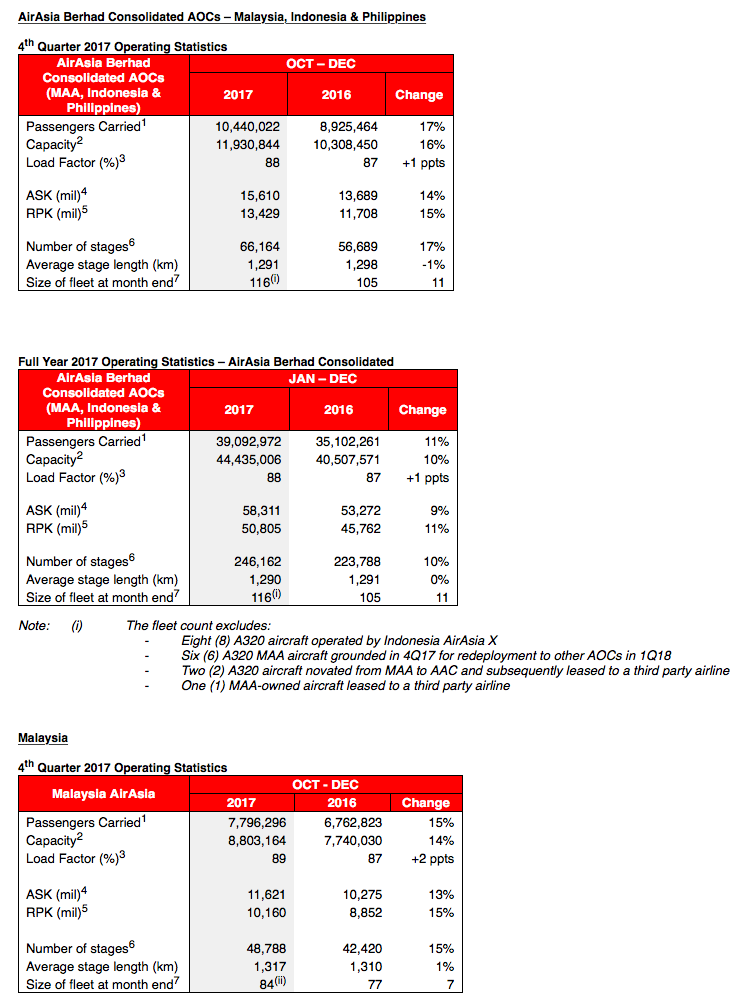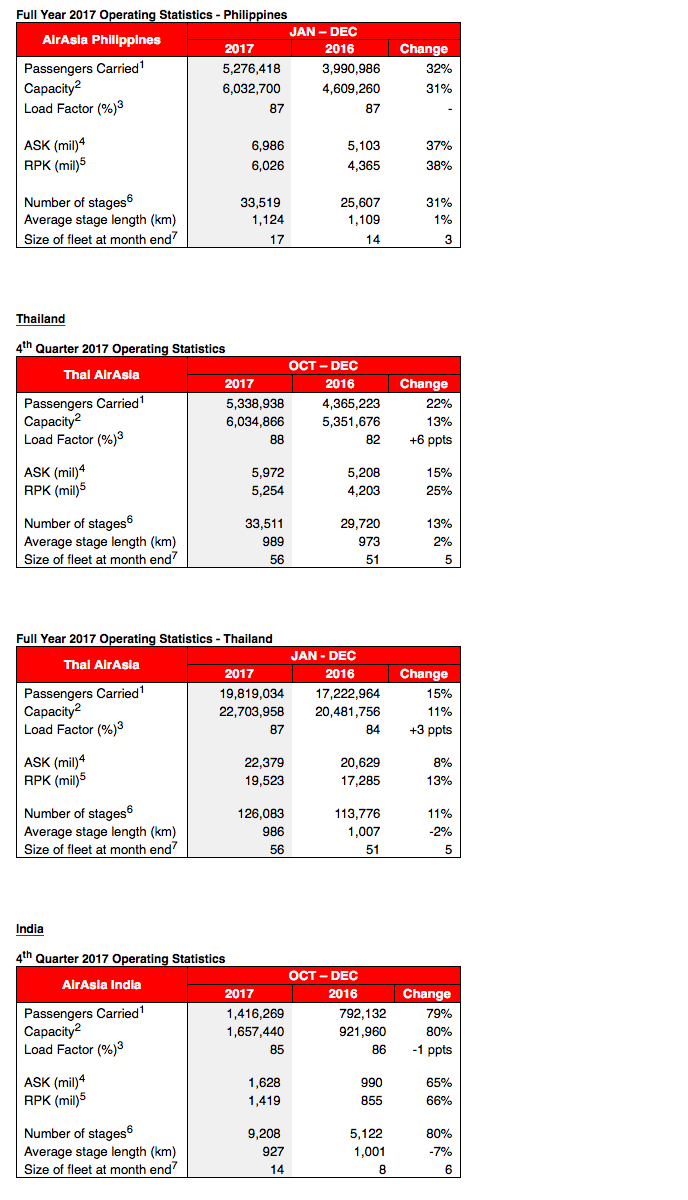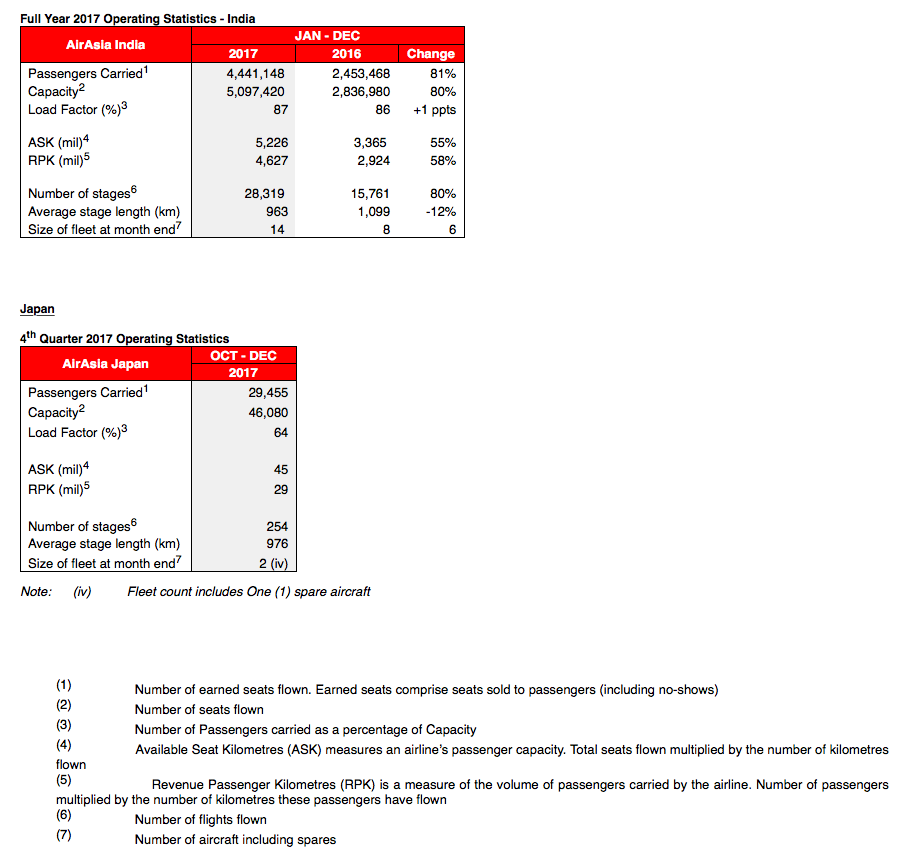AirAsia Berhad is pleased to announce the operating statistics for the 4th Quarter of the 2017 Financial Year (“4Q17”) and the full financial year ended 31 December 2017.
AirAsia Berhad Consolidated AOCs[1] delivered another outstanding set of operating statistics in the seasonally strong fourth quarter. Total passengers carried increased 17% year-on-year to 10.44 million passengers, in-line with the 16% increase in seat capacity. Load factor improved by 1 percentage point to 88% compared the same period in 2016. In the quarter under review, AirAsia Berhad Consolidated AOCs total fleet size grew to 116 aircraft, comprising of 84 in Malaysia (AirAsia Berhad), 15 in Indonesia (PT Indonesia AirAsia) and 17 operating in Philippines (Philippines AirAsia Inc). Malaysia commenced operations of five new routes originating from: Johor–2; Kuala Lumpur–1; Kuching–1; Singapore–1. Philippines commenced operations of two new routes both originating from Manila. Malaysia increased frequencies on 9 routes originating from: Kuala Lumpur–5; Kuching–2; Johor–1; Singapore–1. Indonesia managed to achieve the same full year load factor of 84% as FY2016 despite the volcanic activities of Mt. Agung, which disrupted tourist arrivals into Denpasar. Indonesia increased frequencies on three routes originating from: Bali–2; Jakarta–1. Philippines passengers carried increased by 32% year-on-year and maintained a full year high load factor of 87%. Philippines increased frequencies on two routes originating from Manila. Overall, 2017 was another record year for the group, carrying a total of 39.1 million passengers (+11% year-on-year) with a full year load factor of 88%, rising 1 percentage point from FY2016.
Thai AirAsia (“TAA”) reported a load factor of 88%, jumping by 6 percentage points from the same quarter in 2016. The number of passengers carried during the quarter was 5.34 million, an increase of 22% year-on-year, which was higher than the 13% growth in seat capacity. In 4Q17, TAA grew its total fleet to 56 aircraft, added 2 aircraft during the said quarter, with the total aircraft of 5 delivered for full year of 2017. For the said quarter, TAA commenced operations of one new route originating from Khon Kaen. Frequencies were increased on five routes originating from Bangkok (Don Mueang). Frequencies were reduced from Bangkok to Mandalay from 14 to 7 times weekly, Bangkok to Krabi from 56 to 49 times weekly, Khon Kaen to Hat Yai from 7 to 3 times weekly, as a result of capacity management. For FY2017, TAA carried 19.82 million passengers (+15% year-on-year) and recorded a full year load factor of 87%, up 3 percentage points from FY2016.
AirAsia India (“AAI”) carried 1.42 million passengers in 4Q17, an increase of 79% compared to the same quarter last year in 2016. Load factor was reported at 85%, down by 1 percentage point year-on-year, as a result of an 80% increase in capacity. AAI ended the quarter with a fleet size of 14 aircraft after adding 1 aircraft during the quarter and 6 aircraft for the full year. AAI commenced operations of three new routes originating from: Bangalore–1; Bhubaneswar–1; Hyderabad–1. Frequency was increased on one route originating from Bangalore to Hyderabad, whereas there was a single route reduction originating from Bangalore to Pune. For FY2017, AAI carried 4.44 million passengers (+81% year-on-year) and recorded an average full year load factor of 87%, up 1 percentage point from FY2016.
AirAsia Japan commenced its first flight on 29 October 2017, flying the route between Nagoya and Sapporo.
[1] AirAsia Berhad Consolidated AOCs refers to AOCs whose financial and operational results are consolidated for financial reporting purposes and these are namely the Malaysian, Indonesian and Philippines AOCs.




